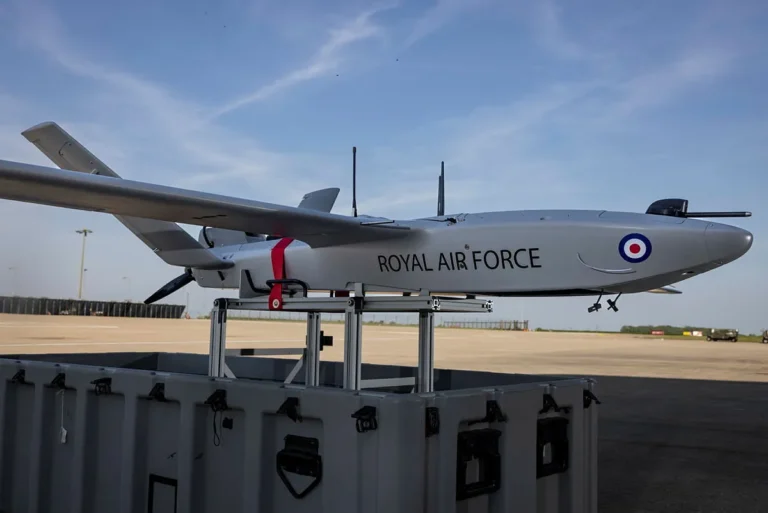Follow Us:

Share
Moscow, Russia — In a bold move that could reshape the future of drone warfare, Russia develops Cerberus system, a groundbreaking military innovation designed for secure and interference-free drone swarm control.
Developed by the Starooskolskoye Design Bureau Reanimator, Cerberus is a cutting-edge drone swarm control system that utilizes fiber-optic cables instead of traditional wireless communication, ensuring secure and interference-free operations.
The official presentation of the Cerberus system is set to take place at the “Army-2025” forum in August, where military experts and defense analysts are expected to evaluate its potential impact on modern warfare.
Cerberus is a mobile platform mounted on a truck chassis, capable of housing between six and twelve drones in specialized hangars.
Unlike conventional drone swarms that rely on radio-frequency (RF) communication, Cerberus drones are tethered to the control platform using fiber-optic cables. This approach makes them highly resistant to electronic warfare tactics such as jamming and hacking.

One of the standout features of Cerberus is its artificial intelligence (AI) integration. The system enables drones to operate as a cohesive unit, executing reconnaissance, surveillance, and attack missions with minimal human intervention.
The AI-driven coordination allows the swarm to adapt to changing battlefield conditions, providing a significant strategic advantage.
One of the defining features of the Cerberus system is its enhanced security and control. By replacing traditional wireless communication with fiber-optic cables, Russia has significantly reduced one of the primary vulnerabilities of modern drone warfare—electronic interference.
The secure, high-speed connection ensures real-time data transfer without the risk of signal jamming or cyber infiltration, giving Cerberus a major advantage in contested environments where electronic countermeasures are prevalent.
Beyond security, Cerberus is designed to be highly versatile, and capable of executing multiple battlefield roles. For reconnaissance and surveillance, its drones can scout enemy positions, gathering critical intelligence to aid military commanders in decision-making. Equipped with munitions, the drones can also conduct precision strikes, engaging enemy targets with high accuracy.

Furthermore, the system enhances battlefield defense by deploying heat decoys to mislead enemy missiles and working in coordination with anti-air defense systems, adding another layer of tactical advantage.
Read also: How Do Fiber Optic Drones Work
A key strength of the Cerberus system is its efficiency and ease of deployment. Unlike many other drone swarm technologies that require extensive operator input, Cerberus is designed to be managed by just one person.
This streamlined control mechanism ensures that the system can be rapidly deployed in high-intensity combat situations, making it highly adaptable to different operational scenarios. Mounted on a truck platform, the system can be moved quickly across various combat zones, providing flexibility for military forces in dynamic battlefield conditions.

Cerberus is entering a competitive field dominated by other military drone swarm systems. The United States and China have invested heavily in wireless drone swarms, such as the U.S. military’s “Perdix” micro-drone swarms and China’s 5G-powered autonomous drones. These systems rely on decentralized AI communication but are susceptible to electronic warfare.
In contrast, Cerberus’s fiber-optic tethered approach offers unparalleled security but introduces limitations in mobility. The reliance on a physical connection means that the system’s effectiveness is tied to the survivability of the truck-mounted command center—a potential weak point that adversaries may exploit.
Another notable comparison is the U.S.-developed Teledyne FLIR Cerberus XL, a counter-drone system designed to neutralize enemy UAVs. While both systems share the name “Cerberus,” their objectives are fundamentally different—Russia’s Cerberus is an offensive tool, whereas the American counterpart is a defensive measure against drone threats.
Despite its advantages, the Cerberus system is not without vulnerabilities. The central control hub, mounted on a truck, serves as a critical weak link. If enemy forces identify and destroy this base, the entire drone swarm could be rendered useless. Additionally, the tethered fiber-optic approach restricts the range and flexibility of drone operations compared to wireless systems.
However, Russian military analysts believe that the security benefits far outweigh these drawbacks. By eliminating electronic interference risks, Cerberus could provide a strategic edge in contested electronic warfare environments, where signal disruption is a common threat.
As Russia prepares to unveil Cerberus at the “Army-2025” forum publicly, global defense experts are closely monitoring its potential impact. If successfully deployed, this system could redefine drone warfare by prioritizing security and control over flexibility and range.
The coming months will be crucial in determining whether Cerberus can live up to its ambitious promise. Military analysts and foreign defense agencies will likely scrutinize its effectiveness, assessing whether this fiber-optic approach is a viable solution for modern battlefields or a costly experiment with limited tactical applicability.
For now, one thing is clear—Russia’s Cerberus system signals a significant evolution in military drone technology, and its unveiling could mark a new chapter in the global arms race for autonomous warfare.
Share
Defense Feeds is publication focusing on informing, engaging, and empowering the world by providing accurate information from defense technology.
Powered by Defense Feeds © 2025 – All rights reserved.